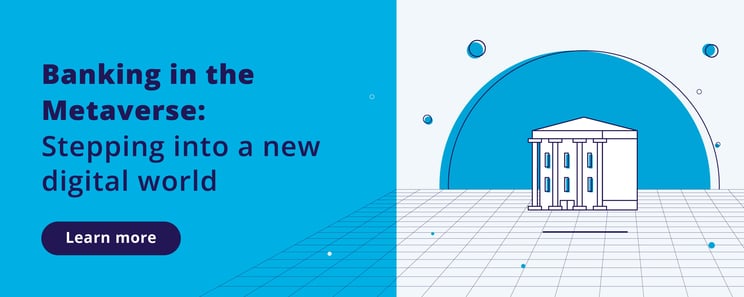It is the major trend that everyone in the tech world is talking about. Metaverse has become one of the buzziest words of the moment, enthusiastically embraced by software developers and business leaders across industries. No one wants to miss the train, and the banking industry is no exception: this new “digital world” opens a series of opportunities for financial institutions, regardless of their size and strategic model. Ignoring its potential or letting other competitors take the lead can be a costly decision for both banking institutions and technology partners.
What is the Metaverse?
In a nutshell, Metaverse is a virtual reality world where users can interact and experience things as they would do in the real world. They can immerse into this world and interact with overlaying objects and people in the visual projected in front of them. Everything is digital, but constantly connected with the real world: users control their own digital avatar, with digital hands and feet, and they are able to walk around and interact with the exterior world within the Metaverse.
Taking benefit from the latest 3D technology, the Metaverse creates a digital replica of everything that we see in the real world. The visual effects can vary from developer to developer: it can look hyper-realistic or just like a cartoon, the design and architectural possibilities are endless.
The most obvious application for the Metaverse is gaming. Most of us have already experienced something similar – creating an avatar, interacting with each other – in other gaming universes. But Metaverse goes beyond 3D virtual worlds. In the Metaverse, each user has its unique identity, just like in the real world, and it may serve as a new medium for social and economic activity, from shopping to real estate transactions. Just like in social media, people will not use the Metaverse only to socialize, but also to work and conduct their personal businesses.
When we combine the Metaverse with Augmented Reality (AR), we open even a wider world of opportunities. Augmented reality is used with smartphones, glasses, and tablets: by scanning a QR Code or other images, users will see 3D objects that appear in front of them. The biggest difference between virtual reality and augmented reality is that you still are inside of the real world and you're not inside a 3D virtual reality. Here you can see and interact with both the real and virtual world at the same time.
Both technologies, especially when combined, are certain to create new opportunities for the banking industry.
Three key questions about banking in the Metaverse
By Paula Oliveira at the ebankIT Summit:
How it will reshape the banking experience
There are no doubt that virtual and augmented reality are here to stay. Younger generations will grow up in an atmosphere molded by these technologies, just like millennials were the first digitally native generation. Banks will have to adapt over and over again to keep the connection with their customers and to build longstanding relationships.
Predicting how these technologies will reshape the banking business is like forecasting the weather. We can read all the signs but still miss something and fail miserably. As always, the only certainty is change, and banks and credit unions will certainly face both the challenge and the opportunity to change their processes and their offer.
Within the Metaverse, banks and credit unions will have the opportunity to get closer to their customers, to facilitate transactions and to offer new products and insights on how to manage their funds. At first, financial institutions can consider developing their own virtual world (a private Metaverse), enabling new products and marketplaces and tying them back to traditional infrastructure. But in the long-term, the most probable solution is a common playground, where both banks and commercial brands will share the attention of end-consumers.
A number of new business strategies is already emerging in the Metaverse. The first is virtual land: users and companies can purchase virtual land, and, according to JP Morgan, the average price of a plot of virtual land already doubled in six months in 2021. And people can also purchase virtual goods, a piece of artwork, shirts, accessories, trees. And these goods can be either stored within that specific world or downloaded and re-upload into different games or worlds. This will probably be a real game changer, up until now things that you bought in a game wouldn’t have any value outside of that game.
Obviously, financial institutions will have a role to represent in this new world, not only mediating digital transactions but also coordinating its connection with the real world. Within the Metaverse, customers will be able to visit virtual branches, search for more personalized services and select their providers according to the digital experience. Imagine, for example, the opportunity to take a house tour with a mortgage broker in real-time or discuss retirement plans with an avatar advisor. Everything is relocated to the Metaverse world.
How Metaverse is reshaping the banking costumer experience
By Paula Oliveira at the ebankIT Summit:
It is not just the future. It is happening right now
If, at first, the word Metaverse sounded like an empty buzzword, now there are growing signs that it is already creating an impact. The rise of cryptocurrency and Non-fungible tokens (NFT’s) can be perceived as the advent of a new digital world, but we are also witnessing a growing number of companies filing trademarks and patents to protect their piece of the Metaverse.
Financial institutions are already in the Metaverse or taking steps to embrace virtual and augmented reality. JP Morgan was the first to open a branch in the Metaverse, BNP Paribas also launched a Virtual Reality app that allows customers to use VR in their banking transactions, including account opening. And there are other interesting examples related to virtual branches, transactions, customer data displayed in augmented reality, and also the usage of virtual reality for training staff.
At ebankIT, we have been working towards this new digital era for a long time. EbankIT Omnichannel Digital Banking platform has entered this world some years ago with an innovative augmented reality solution where users can scan a leaflet or a poster in the branch, in outdoors or also on the website, for example, and see personalized information.
We understand that the Metaverse is a new medium to further humanize the digital banking experience. By merging the real and the virtual world, banks and credit unions have the opportunity to overcome the limitation of a physical screen, bringing finance and people closer together and enabling banking users to manage their funds with additional confidence.
But the emergence of a new digital world stands also as a challenge for banks and credit unions. The customer experience becomes more engaging and financial institutions will need to keep up also with more personalized banking solutions. Customers will demand new tailored products and experiences, based on their data and preferences. Banks will once again have to adapt their strategy to answer the new customers’ needs.
ebankIT at the Metaverse





%20without%20SAM%20-%20Maturity%20Level%20-%202-KO%20edit.webp?width=160&height=57&name=67768-ebankIT%20Platform%20-%20CMMI%20Development%20V2.0%20(CMMI-DEV)%20without%20SAM%20-%20Maturity%20Level%20-%202-KO%20edit.webp)
